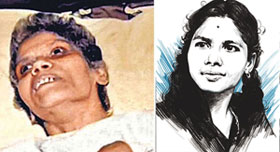Passive Euthanasia: The fundamental right of the terminally ill
Sakshi Education
- Mohan Sai Dutt


In a Landmark Judgement, the Supreme Court declared passive euthanasia and the right of individuals, including the terminally ill, to give advance directives to refuse medical treatment permissible.
The five-member Constitution Bench, led by Chief Justice of India Dipak Misra, in three concurring opinions, upheld that the fundamental right under Article 21(Right to life and dignity) includes right to refuse treatment and die with dignity.
Though the judges gave separate opinions, all of them were unanimous in permitting a 'living will' as they felt that an individual should not be allowed to continue suffering in a vegetative state when they don't wish to continue living, when they are fully aware that they will not revive.
By this the Supreme Court made it very clear that the right to lead a dignified life which is guaranteed under Article 21 of the Constitution extends up to the point of having a dignified death.
What is active and passive euthanasia?
The apex court, in the Aruna Shanbaug case (2011), said that active euthanasia “entails the use of lethal substances or forces to kill a person, e.g., a lethal injection…”. This means that a terminally-ill patient is administered a lethal drug or substance intentionally in order for them to pass away peacefully, in this case, in the event of terminal illness.
While legalizing passive euthanasia, the Supreme Court defined active euthanasia as “a positive act or affirmative action or act of commission entailing the use of lethal substances or forces to cause the intentional death of a person by direct intervention, e.g., a lethal injection given to a person with terminal cancer who is in terrible agony.”
Passive euthanasia also called negative euthanasia or non-aggressive euthanasia, on the other hand, was defined by the apex court, as that which “entails withholding of medical treatment for continuance of life, e.g. withholding of antibiotics where without giving it a patient is likely to die…”. This means that if a patient has been kept alive by the use of life-saving medical equipment, such as a ventilator, or drugs or substances, such as food administered through a pipe or medicines, then these would be stopped and the patient would be allowed to die a ‘natural course of death’.
What is ‘living will’?
The “living will” is a person’s right to issue advance directive on the course of his/her treatment, including withdrawal of life support, should such a situation arise. However, there is no way a living will provision can be made foolproof requiring no intervention of the doctor or immediate decision makers around a person.
Aruna Shanbaug case
In 2011, the Supreme Court, while hearing the case of Aruna Shanbaug, who was in a vegetative state for more than 40 years, had legalised passive euthanasia partially.
A nurse at KEM Hospital in Mumbai, Shanbaug was in a vegetative state since 1973 after a brutal sodomisation and strangling with a dog-chain during a sexual assault. She died in 2015 while on a ventilator for several days after suffering from pneumonia.
Supreme Court gave patients living in a vegetative state the right to have treatment or food withdrawn, and laid down guidelines to process passive euthanasia in the case of incompetent patients. The guidelines included seeking a declaration from a high court, after getting clearance from a medical board and state government.
Present judgment
Supreme Court in its present judgment allowed “living will” where, an adult in his conscious mind, is permitted to refuse medical treatment or voluntarily decide not to take medical treatment to embrace death in a natural way. In its judgment, the court has laid down a set of guidelines for “living will” and defined passive euthanasia and euthanasia as well.
The Chief Justice's judgment also includes specific guidelines to test the validity of a living will,
Who is allowed to execute or draw up the will?
What should the will speak about?
How should the will be recorded, preserved?
When and by whom can it be given effect to?
The guidelines also cover a situation where there is no living will and how to approach a plea for passive euthanasia.
How this Judgement effect the suffering lives?
This decision helps the patients alleviate their pain, suffering, and depression. Individuals have the liberty right, which includes the right of owing their death. For instance, the patients who have some terrible disease must be trapped with hospital bed with miserable pain each day. They do not want to endure it, but instead, they wish to assuage it. It is clear that patients’ decision to ask for a cessation in treatment, reflecting their own preference for death rather than for a continuation of discomfort or suffering. Therefore, that individual’s decision should be carried out because they have that right to their own personal decisions.
Another reason is the mercy killing can reduce inconveniences, emotional and physical burdens, and drawbacks imposed on family members, relatives, and friends of patients. Apart from the miserable pain that the patients suffer, the trauma and the emotional havoc their relatives go through is also immense. Besides, their family members may be sensitive to the costs accumulating during terminal care. Consequently, patients may feel guilty in this entire ordeal, may even become more severely ill. Obviously, the patients will not need to worry about their family and their pain anymore once euthanasia is performed.
The death of Aruna Shanbaug has brought about the necessary revolution in Indian Judiciary as passive Euthanasia is now legal in India.
Major concerns in case of India
Permitting Passive Euthanasia can have some negative consequences in India's corrupt medical and legal system and especially at a time when human relations are increasingly monetized and criminalized. Though there are many moral, human and economic reasons to justify Euthanasia, any move towards this should be preceded by strong regulation. At a time when medical science is expanding into new frontiers, what is incurable can perhaps be curable tomorrow.
Euthanasia in other countries
There are many countries across the world which made Passive Euthanasia Legal.
Countries that allow euthanasia have safeguards built into the provision in various ways:
Netherlands: Patients aged 16 or above may make advance directives.
Hungary: Pregnant women can’t refuse treatment if they’re able to carry through the pregnancy.
Germany: Court authorization required to stop treatment of a minor.
Switzerland: Persons with mental illnesses cannot discontinue treatment if it is expression or symptom of their mental illness.
Australia: Living wills to be signed in presence of two witnesses, with rules on who can be witness: Not if he/ she 1) is a substitute decision-maker in the living will, 2) stands to profit, directly or indirectly, from the person’s estate or 3) is a health practitioner for the person writing the living will.
UK: Person can alter/ withdraw an advance decision at any time he has the capacity to do so.
Oregon, US: Person can change his/ her mind at any time and as many times, quash a written request for medication regardless of mental state.
The policy makers of this country must consider these global practices while making the law. This can help in bringing down the loopholes in the law made.
Way forward
Stringent laws and strict vigil by the administration in implementation of euthanasia should ensure safeguards against such a situation, and other instances of coercion and fraud.
Every case will have to be carefully monitored taking into consideration the point of views of the patient, the relatives and the doctors. This decision is based on the patients' rights and dignity, doctors' rights, religious beliefs, society's views, morality and other resolutions available.
Obviously legalization of euthanasia should not include anyone wanting to end their life at the flimsiest of excuses. Taking this into account the Kerala Law Reforms panel suggested that mercy killing should be carried out with the written sanction of three state-recognized doctors certifying that the patient under consideration is a fit case for euthanasia.
At present doctors are afraid to openly discuss end-of-life decisions with patients due to absence of any legislation. This prevents an open and honest relationship between doctor and patient in which the doctor can discover the patient’s wishes regarding his/her own life and death.
Conclusion
Though religion, morality, philosophy, law and society shared equally strong and conflicting opinions whether right to life included right to death, they all agreed that a person should die with dignity.
The five-member Constitution Bench, led by Chief Justice of India Dipak Misra, in three concurring opinions, upheld that the fundamental right under Article 21(Right to life and dignity) includes right to refuse treatment and die with dignity.
Though the judges gave separate opinions, all of them were unanimous in permitting a 'living will' as they felt that an individual should not be allowed to continue suffering in a vegetative state when they don't wish to continue living, when they are fully aware that they will not revive.
By this the Supreme Court made it very clear that the right to lead a dignified life which is guaranteed under Article 21 of the Constitution extends up to the point of having a dignified death.
What is active and passive euthanasia?
The apex court, in the Aruna Shanbaug case (2011), said that active euthanasia “entails the use of lethal substances or forces to kill a person, e.g., a lethal injection…”. This means that a terminally-ill patient is administered a lethal drug or substance intentionally in order for them to pass away peacefully, in this case, in the event of terminal illness.
While legalizing passive euthanasia, the Supreme Court defined active euthanasia as “a positive act or affirmative action or act of commission entailing the use of lethal substances or forces to cause the intentional death of a person by direct intervention, e.g., a lethal injection given to a person with terminal cancer who is in terrible agony.”
Passive euthanasia also called negative euthanasia or non-aggressive euthanasia, on the other hand, was defined by the apex court, as that which “entails withholding of medical treatment for continuance of life, e.g. withholding of antibiotics where without giving it a patient is likely to die…”. This means that if a patient has been kept alive by the use of life-saving medical equipment, such as a ventilator, or drugs or substances, such as food administered through a pipe or medicines, then these would be stopped and the patient would be allowed to die a ‘natural course of death’.
What is ‘living will’?
The “living will” is a person’s right to issue advance directive on the course of his/her treatment, including withdrawal of life support, should such a situation arise. However, there is no way a living will provision can be made foolproof requiring no intervention of the doctor or immediate decision makers around a person.
Aruna Shanbaug case
In 2011, the Supreme Court, while hearing the case of Aruna Shanbaug, who was in a vegetative state for more than 40 years, had legalised passive euthanasia partially.
A nurse at KEM Hospital in Mumbai, Shanbaug was in a vegetative state since 1973 after a brutal sodomisation and strangling with a dog-chain during a sexual assault. She died in 2015 while on a ventilator for several days after suffering from pneumonia.
Supreme Court gave patients living in a vegetative state the right to have treatment or food withdrawn, and laid down guidelines to process passive euthanasia in the case of incompetent patients. The guidelines included seeking a declaration from a high court, after getting clearance from a medical board and state government.
Present judgment
Supreme Court in its present judgment allowed “living will” where, an adult in his conscious mind, is permitted to refuse medical treatment or voluntarily decide not to take medical treatment to embrace death in a natural way. In its judgment, the court has laid down a set of guidelines for “living will” and defined passive euthanasia and euthanasia as well.
The Chief Justice's judgment also includes specific guidelines to test the validity of a living will,
Who is allowed to execute or draw up the will?
What should the will speak about?
How should the will be recorded, preserved?
When and by whom can it be given effect to?
The guidelines also cover a situation where there is no living will and how to approach a plea for passive euthanasia.
How this Judgement effect the suffering lives?
This decision helps the patients alleviate their pain, suffering, and depression. Individuals have the liberty right, which includes the right of owing their death. For instance, the patients who have some terrible disease must be trapped with hospital bed with miserable pain each day. They do not want to endure it, but instead, they wish to assuage it. It is clear that patients’ decision to ask for a cessation in treatment, reflecting their own preference for death rather than for a continuation of discomfort or suffering. Therefore, that individual’s decision should be carried out because they have that right to their own personal decisions.
Another reason is the mercy killing can reduce inconveniences, emotional and physical burdens, and drawbacks imposed on family members, relatives, and friends of patients. Apart from the miserable pain that the patients suffer, the trauma and the emotional havoc their relatives go through is also immense. Besides, their family members may be sensitive to the costs accumulating during terminal care. Consequently, patients may feel guilty in this entire ordeal, may even become more severely ill. Obviously, the patients will not need to worry about their family and their pain anymore once euthanasia is performed.
The death of Aruna Shanbaug has brought about the necessary revolution in Indian Judiciary as passive Euthanasia is now legal in India.
Major concerns in case of India
Permitting Passive Euthanasia can have some negative consequences in India's corrupt medical and legal system and especially at a time when human relations are increasingly monetized and criminalized. Though there are many moral, human and economic reasons to justify Euthanasia, any move towards this should be preceded by strong regulation. At a time when medical science is expanding into new frontiers, what is incurable can perhaps be curable tomorrow.
Euthanasia in other countries
There are many countries across the world which made Passive Euthanasia Legal.
Countries that allow euthanasia have safeguards built into the provision in various ways:
- By specifying who may act as a witness
- By allowing a person to change his/her mind
- By allowing the validity of directive to be challenged
Netherlands: Patients aged 16 or above may make advance directives.
Hungary: Pregnant women can’t refuse treatment if they’re able to carry through the pregnancy.
Germany: Court authorization required to stop treatment of a minor.
Switzerland: Persons with mental illnesses cannot discontinue treatment if it is expression or symptom of their mental illness.
Australia: Living wills to be signed in presence of two witnesses, with rules on who can be witness: Not if he/ she 1) is a substitute decision-maker in the living will, 2) stands to profit, directly or indirectly, from the person’s estate or 3) is a health practitioner for the person writing the living will.
UK: Person can alter/ withdraw an advance decision at any time he has the capacity to do so.
Oregon, US: Person can change his/ her mind at any time and as many times, quash a written request for medication regardless of mental state.
The policy makers of this country must consider these global practices while making the law. This can help in bringing down the loopholes in the law made.
Way forward
Stringent laws and strict vigil by the administration in implementation of euthanasia should ensure safeguards against such a situation, and other instances of coercion and fraud.
Every case will have to be carefully monitored taking into consideration the point of views of the patient, the relatives and the doctors. This decision is based on the patients' rights and dignity, doctors' rights, religious beliefs, society's views, morality and other resolutions available.
Obviously legalization of euthanasia should not include anyone wanting to end their life at the flimsiest of excuses. Taking this into account the Kerala Law Reforms panel suggested that mercy killing should be carried out with the written sanction of three state-recognized doctors certifying that the patient under consideration is a fit case for euthanasia.
At present doctors are afraid to openly discuss end-of-life decisions with patients due to absence of any legislation. This prevents an open and honest relationship between doctor and patient in which the doctor can discover the patient’s wishes regarding his/her own life and death.
Conclusion
Though religion, morality, philosophy, law and society shared equally strong and conflicting opinions whether right to life included right to death, they all agreed that a person should die with dignity.
Published date : 13 Mar 2018 01:28PM













